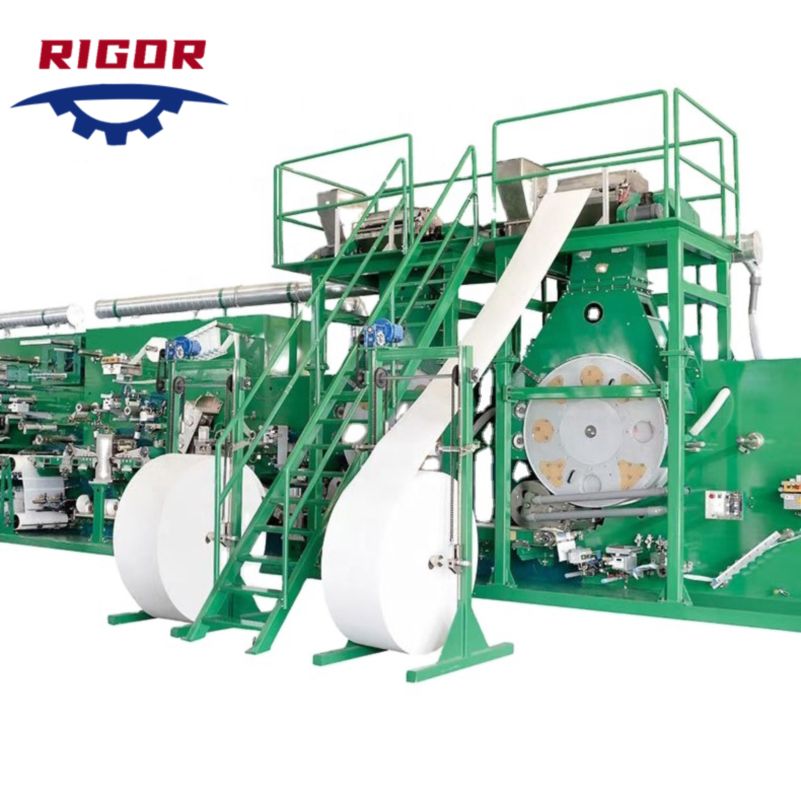Manufacturers of diaper machinery ensure compliance with international standards and regulations governing production through several key practices:
- Thorough Understanding of Regulations: Manufacturers invest in understanding the relevant international standards and regulations governing the production of diapers and diaper machinery. This includes standards set by organizations such as the International Organization for Standardization (ISO), ASTM International, and specific regulatory bodies in target markets.
- Adherence to Safety Standards: Manufacturers design and engineer diaper machinery to meet or exceed safety standards established by relevant regulatory bodies. This includes ensuring the safety of operators, compliance with electrical and mechanical safety requirements, and adherence to guidelines for machine guarding and hazard mitigation.
- Certification and Compliance Testing: Manufacturers seek certification and conduct compliance testing for their diaper machinery to validate adherence to international standards and regulations. This may involve obtaining certifications such as CE marking (for the European Union), UL listing (for the United States), or certification from other recognized conformity assessment bodies.
- Documentation and Traceability: Manufacturers maintain comprehensive documentation throughout the design, manufacturing, and testing processes to demonstrate compliance with international standards and regulations. diaper manufacturer This includes documentation of design specifications, materials used, manufacturing processes, quality control measures, and compliance testing results. Additionally, manufacturers implement systems for traceability to track components and materials used in diaper machinery production.
- Quality Management Systems: Manufacturers implement robust quality management systems (QMS) based on internationally recognized standards such as ISO 9001 to ensure consistency, traceability, and compliance throughout the manufacturing process. QMS frameworks facilitate continuous improvement, risk management, and adherence to regulatory requirements.
- Training and Education: Manufacturers invest in training and education for their employees to ensure awareness and understanding of international standards and regulations governing diaper machinery production. This includes training on safety protocols, quality assurance procedures, regulatory requirements, and documentation practices to maintain compliance.
- Supplier Qualification and Oversight: Manufacturers rigorously evaluate and qualify suppliers of components, materials, and services to ensure they meet the necessary quality, safety, and regulatory requirements. Suppliers are expected to provide documentation, certificates of compliance, and other evidence of adherence to applicable standards.
- Continuous Monitoring and Auditing: Manufacturers conduct regular internal audits and assessments to monitor compliance with international standards and regulations. This includes evaluating processes, procedures, documentation, and product quality to identify areas for improvement and ensure ongoing adherence to regulatory requirements.
- Engagement with Regulatory Bodies: Manufacturers actively engage with regulatory bodies, industry associations, and other stakeholders to stay informed about changes in regulations and standards relevant to diaper machinery production. This may involve participating in industry forums, advocacy efforts, and collaboration with regulatory agencies to influence policy development and ensure alignment with industry best practices.
By implementing these practices, manufacturers of diaper machinery can ensure compliance with international standards and regulations governing production, diaper manufacturers thereby meeting customer expectations, mitigating risks, and maintaining market access in target regions.
How do manufacturers address the need for sustainability and eco-friendly practices in diaper?
Manufacturers of diapers address the need for sustainability and eco-friendly practices through various initiatives aimed at reducing environmental impact across the entire product lifecycle.
Here are some strategies they commonly employ:
- Material Selection: Manufacturers prioritize the use of sustainable and eco-friendly materials in diaper production. This includes sourcing renewable and biodegradable materials such as sustainably sourced wood pulp for absorbent cores, plant-based fibers for topsheets and backsheets, and eco-friendly adhesives and elastics.
- Resource Efficiency: Manufacturers optimize resource utilization and minimize waste generation during the manufacturing process. This may involve implementing energy-efficient production technologies, water-saving measures, and waste reduction strategies such as recycling and reuse of manufacturing by-products.
- Reduced Packaging: Manufacturers explore ways to minimize packaging materials and adopt eco-friendly packaging solutions for diapers. This includes using recycled and recyclable materials, reducing packaging weight and volume, and optimizing packaging design to minimize environmental impact throughout the supply chain.
- Carbon Footprint Reduction: Manufacturers strive to reduce the carbon footprint associated with diaper production and distribution. This includes optimizing transportation logistics, sourcing materials locally to reduce transportation emissions, and investing in renewable energy sources such as solar or wind power for manufacturing facilities.
- Product Innovation: Manufacturers invest in research and development to innovate new eco-friendly diaper designs and technologies. This includes developing diapers with improved biodegradability, compostability, and recyclability, as well as exploring alternative materials and manufacturing processes with lower environmental impact.
- Life Cycle Assessment (LCA): Manufacturers conduct life cycle assessments to evaluate the environmental impact of diapers from raw material extraction to end-of-life disposal. diaper manufacturing companies This helps identify hotspots and opportunities for improvement throughout the product lifecycle and informs decision-making to prioritize sustainability initiatives.
- Certifications and Standards: Manufacturers seek certification from recognized organizations such as the Forest Stewardship Council (FSC), Programme for the Endorsement of Forest Certification (PEFC), and Cradle to Cradle Certified™ to demonstrate their commitment to sustainability and compliance with eco-friendly standards.
- Consumer Education: Manufacturers engage with consumers to raise awareness about the environmental benefits of eco-friendly diapers and encourage sustainable diapering practices. This includes providing information about composting options, proper disposal methods, and the importance of choosing environmentally responsible diaper products.
- Supply Chain Collaboration: Manufacturers collaborate with suppliers, partners, and stakeholders across the supply chain to promote sustainability initiatives and drive collective action. This may involve sharing best practices, setting sustainability targets, and working together to address common challenges related to environmental sustainability.
- Transparency and Reporting: Manufacturers are transparent about their sustainability efforts and regularly report on progress towards environmental goals. This includes disclosing environmental performance metrics, carbon emissions data, and sustainability initiatives in corporate sustainability reports and public communications.
By implementing these strategies, manufacturers of diapers can reduce their environmental footprint, meet consumer demand for eco-friendly products, and contribute to a more sustainable future for the diaper industry.
